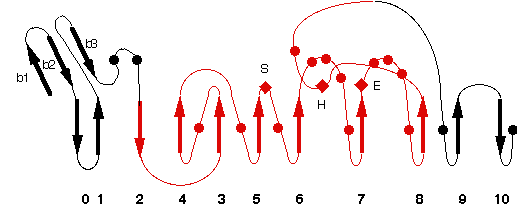2XB6
Name : Revisited crystal structure of Neurexin1beta-Neuroligin4 complex
Revelation date : 23-Jun-2010
Family : Neuroligin
Gene_locus : human-NLGN4X
PDB file : ESTHER: header of PDB entry RCSB: Full entry
Comment
Leone, P., Comoletti, D., Ferracci, G., Conrod, S., Garcia, S.U., Taylor, P., Bourne, Y., Marchot, P.
Ligand :
References (1)
| Title : Structural insights into the exquisite selectivity of neurexin\/neuroligin synaptic interactions - Leone_2010_EMBO.J_29_2461 |
| Author(s) : Leone P , Comoletti D , Ferracci G , Conrod S , Garcia SU , Taylor P , Bourne Y , Marchot P |
| Ref : EMBO Journal , 29 :2461 , 2010 |
| Abstract : Leone_2010_EMBO.J_29_2461 |
| ESTHER : Leone_2010_EMBO.J_29_2461 |
| PubMedSearch : Leone_2010_EMBO.J_29_2461 |
| PubMedID: 20543817 |
| Gene_locus related to this paper: human-NLGN4X |
Representative scheme of Prolylcarboxypeptidase structure and an image from PDBsum server

